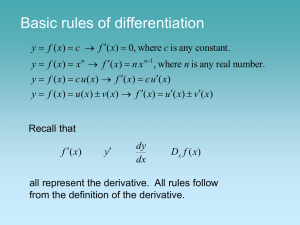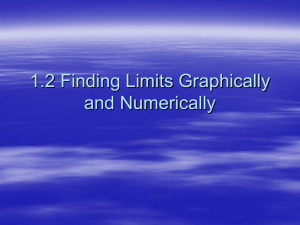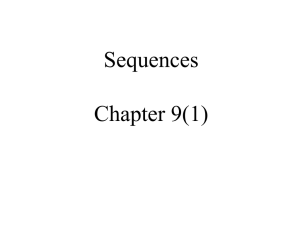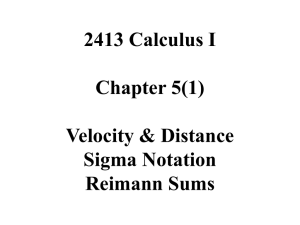sect. 1-3
advertisement
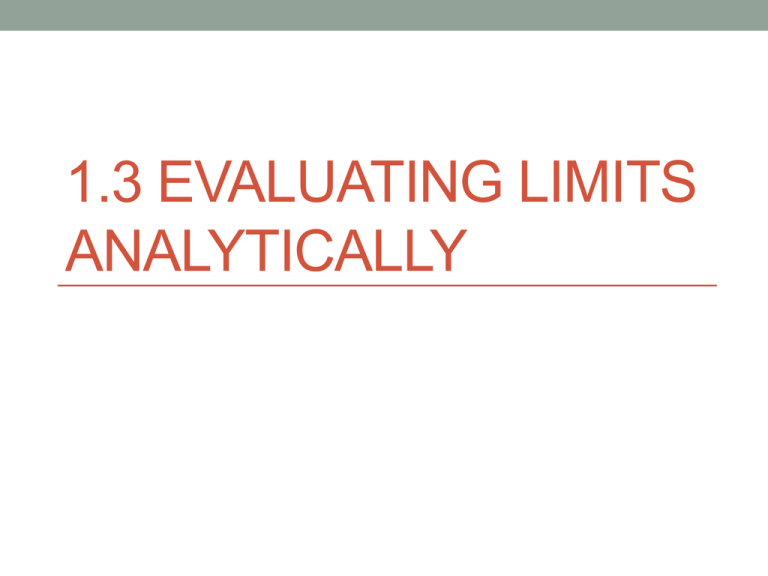
1.3 EVALUATING LIMITS ANALYTICALLY Direct Substitution • If the the value of c is contained in the domain (the function exists at c) then lim f (x) f (c) xc Direct Substitution is valid for ALL polynomials and rational functions with non-zero denominators 1) Find 2) lim x 4 x 9 4 x 3 x3 Find lim x 3 x 2 2 Properties Of Limits Basic - let b and c be real numbers and n be a positive integer I. Constant limb b x c II. III. Identity Power lim x c x c n lim x c n xc Properties Of Limits Let L, K, b, and, c be real numbers, let n be a positive integer, and lim f (x) L and lim g(x) K xc 1. x c b f (x) L Scalar Multiple: lim xc 1 1 lim2x 2lim3x 3 2 x 2 x 2 2 2(1) 2. Sum/Difference:lim f (x) g(x) L K xc lim3x 2 2x lim 3x 2 lim2x x 4 x 4 x 4 2 3(4) 2(4) Properties Of Limits Let L, K, b, and, c be real numbers, let n be a positive integer, and lim f (x) L and lim g(x) K x c xc 3. a a Power: lim f (x) L b b x c 4. Product: lim f (x) g(x) L K xc lim2x 1x 3 lim2x 1limx 3 x0 x0 x0 2(0) 10 3 Properties Of Limits Let L, K, b, and, c be real numbers, let n be a f (x) L and lim g(x) K positive integer, and lim xc x c f (x) L K 0 5. Quotient: lim x cg(x) K x 2 9 lim x 2 9 x 4 lim x 4 x x lim x 4 2 (4) 9 4 3) Find x2 x 2 lim 2 x 1 x 1 0 0 Technique 1: Rewrite the function by factoring out Common factors 4) Find lim x 1 2 x 3 x3 0 0 Technique 2: Rationalize the numerator By multiplying by the complex conjugate 5) Find 1 1 lim 2 x 2 x 0 x 0 0 Technique 3: Use algebra to rewrite the the function Strategies for Limits 1) Determine by recognition whether a limit can be evaluated by direct substitution 2) If direct substitution fails, try to use some technique (cancellation, rationalization, or algebraic manipulation) 3) Use a graph or table to verify your conclusion x 2 3x 10 6) Find lim x 2 x 2 x 6 2(x x) 2x 7) Find lim x0 x 8) Find x 1 1 lim x 0 x 9) Use lim f ( x ) 2and lim g ( x ) 3 x c lim[5 g ( x)] x c lim[ f ( x) g ( x)] x c lim[ f ( x) g ( x)] x c f ( x) lim x c g ( x ) x c Homework Page 67 # 5 – 25 odd, 37, 38, 39, 41-57 odd,

